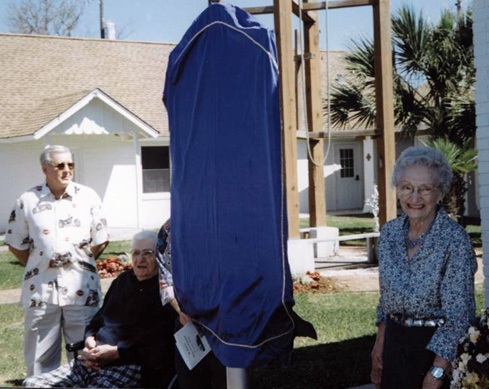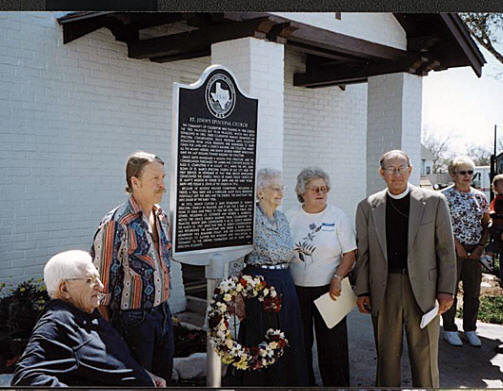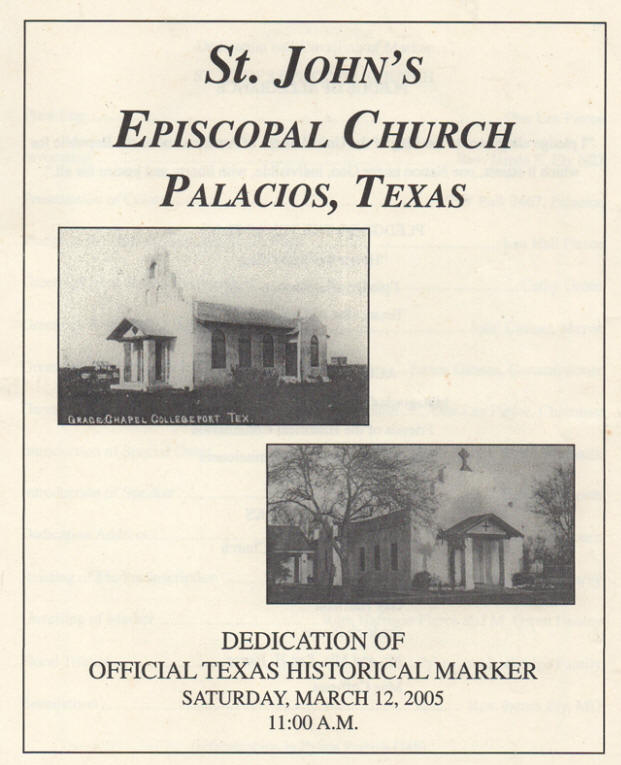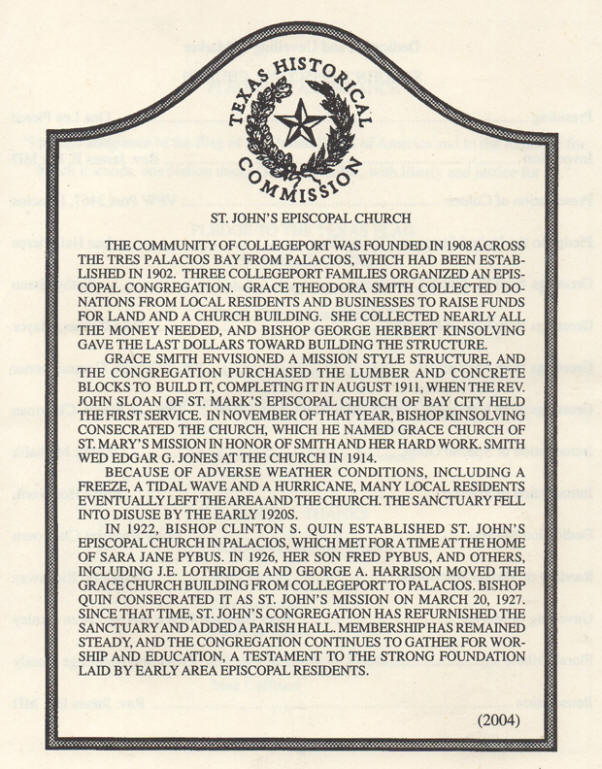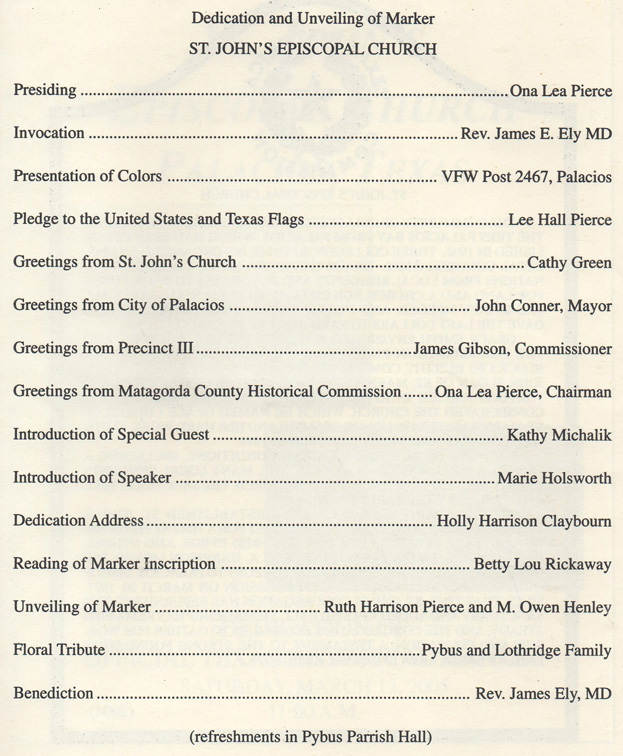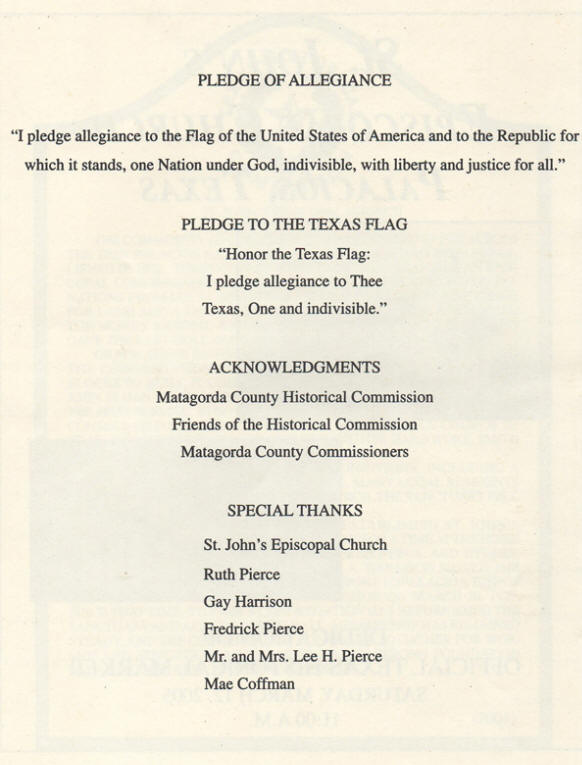|
300 3rd Street 28°42'5.86"N 96°12'47.73"W |
||||
|
Written by Mary Belle Ingram
Collegeport, founded in 1908, is situated in southwestern Matagorda County on the east side of Tres Palacios Bay in Matagorda County and only a mile and half by boat across the bay to the west and 22 miles by land is situated the town of Palacios founded in 1902. This is where this interesting history of two church congregations unfolds because of one individual who had a dream and the many who followed to fulfill that dream. Sturdy little St. John’s Episcopal Church at Main and Third Street in Palacios, Texas, traces its origin to the year 1910, when St. Mary’s Mission, Collegeport, Texas, was established by Bishop George Herbert Kinsolving of Austin, Texas, and Reverend John Sloan of St. Mark’s Episcopal Church in Bay City, Texas, for just three Episcopal families of the Collegeport area. These three families desiring a church building of their own in Collegeport, their dream took form through the efforts of an extraordinary twenty-four year old lady named Grace Theodora Smith. Grace Smith had a dream of a place of beauty and inspiration in which to worship the Lord and celebrate His Eucharist. Her knowledge of how to go about building such a structure, plus a faith that God would make it possible as she set her eyes on the stars. She was not misled, for the number of people who came forward, not with big sums of money, but everything from fifty cents up, was astounding. Business firms from a wide area also joined the flame of enthusiasm that had been lit. Furnishings, paint, rugs, and much more came in. It was truly a work of the people. Grace listed each contribution and contributor as well as expenses. The contributions amounted to 90% of the money spent. The finished church building would be worth $2,500 and the land $3,500. In those days people went to a lumber yard, figured what they needed, and when the lumber was loaded in the buyer’s wagon, it was considered his and the yard better not have made any mistakes because the deal was closed. On March 28, 1911, Grace Smith received a note from Bishop George Herbert Kinsolving stating that her letter with the deed had arrived. He was grateful to learn that their work at Collegeport was alive and progressing. He said he would give her $200 on the last payment of the building. The design and appearance of the building was Mission Style. It was constructed of concrete, the inside walls being plastered and tinted a rich, deep cream color to harmonize with the mission woodwork. The windows were of Florentine glass and the doors were of special design done in mission to correspond with the architecture of the building. Even the organ was finished to match the woodwork and the effect as one entered the chapel was peaceful and inspiring giving an ideal environment in which to worship one’s Maker. Two months after the laying of the cornerstone, the building was finished.
On November 25, 1911, Bishop Kinsolving met the vestry at St. Mark’s Episcopal Church in Bay City and consulted about the new church building. The next day on November 26, 1911, Bishop Kinsolving consecrated Grace Church at Collegeport, baptized an infant, preached, and celebrated the Holy Communion. The Bishop wrote, “It was a fine service and the building is one of the most beautiful little churches in the Diocese, largely the result of the labor of love of a young lady whom I had confirmed the year before in a schoolhouse at Collegeport.” Bishop Kinsolving named the church “Grace Church of St. Mary’s Mission.” Reverend John Sloan posted church services for a Monday which was to be a surprise wedding service to all except the relatives of the bride and groom. It said, “Special Service Monday, August 31st, being Monday before the nativity of the Blessed Virgin Mary, Song and Sermon, 7:30 p. m”. On Monday, August 31st, 1914, Edgar G. Jones of Amarillo and Grace Smith were married in Grace Chapel by the Reverend John Sloan. In the early 1920s, Grace Church fell into disuse when the congregation moved away from Collegeport due to severe conditions in the area. A severe freeze and tidal wave brought salt into the fields causing many residents to leave. A hurricane did major damage and the organ of Grace Chapel was found outside. The organ was cleaned and restored, playing as good as new. In 1922 the congregation of St. John’s Church in Palacios was established by the Reverend Clinton S. Quin, D. D. Bishop of Texas. The first congregational meeting was held in the Palacios Presbyterian church. It was early winter and the janitor started a fire in the stove. The chimney was stuffed tight with sparrow nests and a cloud of smoke drove all from the room. James Sartwelle invited the group to his home to conduct their business. On July 1, 1925, Lots 9-12, Block 24 was conveyed to St. John’s Mission in Palacios, Texas, of the Protestant Episcopal Church of American by Mary H. Elder. $350 was paid in cash and two notes for $200 each would be due July 1, 1926, and July 1, 1927. St. John’s was organized as a mission in 1926 with the Reverend Paul E. Engle as priest in charge. As it was being organized, the congregation of St. John’s worshipped that first year in the home of Mrs. Sara Jane Pybus. The congregation was in need of a church building of their own, just as Grace Chapel in Collegeport was in need of rescue. Bishop Clinton S. Quin gave his permission for the church to be dismantled and hauled in pieces to Palacios, where it was reassembled and consecrated as St. John’s Mission by Bishop Quin on March 20, 1927. The enormous effort of moving the church across the bay and land was personally completed by J. E. Lothridge, Fred Pybus, and George A. Harrison with the help of family groups who made up the core of St. John’s Episcopal Church. George Harrison moved the large pieces 22 miles around the bay by truck on undeveloped dirt roads. Each day they traveled back and forth by boat and land from Palacios to Collegeport and the women prepared lunch for the workers. One can scarcely imagine the work and loving dedication it must have required to dismantle the chapel in Collegeport and bring it to Palacios where it was rebuilt piece by piece and erected in the exact same size and design as when in Collegeport. Mr. J. P. Jensen of Palacios, Texas, was the building contractor for rebuilding the church. The church furnished the materials paying Mr. Jenson $150 when the roof was completed and $200 when the building was completed. To continue working on the church ten promissory notes were obtained for $100 each dated January 25, 1927, payable yearly to John R. Rowls. On the 24th of August, 1939, a release was given the church from the Rowls Estate as payment was made in full. By 1930 the stucco was coming off and a refurbishing job began. A brick veneer was chosen for refinishing the exterior of the building. The women of the Guild experimented in making molds of brick. The making and laying of brick was managed by Dr. T. H. Hood, a retired dentist from Chicago, who also made the credence shelf, the hymn tablet and the altar cross. Pews and a large bell were donated from the dismantled Hawley Church by Pearl Smith, Grace Heffelfinger, and Abel Pierce in memory of their mother, Nannie Lacy Pierce. Mrs. John A. Harrison gave the Bible in memory of her husband. The clergy who served in those first years were the Reverends Frank A. Rhea, John Sloan, and John Shea. On May 6, 1950, Joe A. Birkner was hired to construct a 30’x60’ vertical cell tile building set on a concrete slab with double hand aluminum windows and a shingle roof for $6,000 with Reverend Aubrey C. Maxted in charge. This building contained classrooms, office, kitchen, hall, and rest rooms and was named the Pybus Parish Hall. A plaque was placed on this building reading:
On September 5, 1979, for insurance purposes the value of the silver, brass, two stained glass windows, vestments, altar hangings and furniture in the church amounted to $16,000. Special occasions of the church are rally day when church members sign up to help in the Church, Easter when special flowers are brought in memory of family and to give thanks; Christmas Eve services and Lent. During Lent there is a pancake supper which is a fund raiser. On Palm Sunday there is a procession with palms and at times this procession is carried outside down the street. Sunday School is 9:30 a.m. and church services at 10:30 a.m. each Sunday. Average attendance was 17 to 25 when they met in the home of Sara Jane Pybus on Sunday evenings before the church was constructed. In the 1930s and 1940s attendance was from 40 to 50. Membership has been steady since the 1950s to date [2004] averaging from 40 to 50. In addition to the ministers previously mentioned as serving the early church, others serving have been Paul Engle, 1925 - Dec. 1,1941; Nathaniel Chasee Croft, 1941 - 1943; Edmund Lucien Malone, Jr., 1943 - April 9, 1944; Aubrey Clement Maxted, September 15, 1944 - June 10, 1956; Nelson Charles Longnecker, June 15, 1956 - June 15, 1958; Ralph Leeper Masters, June 15, 1958 - May 22, 1961; Billy Cullen Grisson, June 15, 1961 - December 31, 1961; Das Kelly Barnett, September 1, 1962 - November 30, 1964; John Raymond Fisher March 11, 1965 - August 1966; James Edward Scott, Jr., August 1, 1967 - January 31, 1970; James Milton Abernathey, June 1, 1970 - January 1, 1974; Robert Morgan Tarbet, Jr., January 1, 1974 - December 26, 1976; James P. Dale, Robert S. Kemp, and Doug Cadwallader, 1977-1981; Jack Stevens Lowrey, June 1, 1981 - August 4, 1985; Herbert A. Willke, September 15, 1985 - April 26, 1992; Karl M. Choate, July 1, 1992 - July 20, 1997; James E. Ely, November 23, 1997 to present date [2004]. Presently in the year 2004, Bishop Don Wimberley serves with the lay Vicar Dr. James Ely. The Bishop’s committee serving are Senior Warden Marie Holsworth, Junior Warden Will Scott, and members Reba Ford, Cathy Porter, Kathy Michalik, Chad Huddleston, Marty Crain, Cathy Green, and Holly Claybourn. At St. John’s Episcopal Church Roxanne Crain is in her fifth year [2004] of teaching the children’s Sunday School with assistants Jana Huddleston and Sandra Davant. P. J. Prather teaches the high school youth and the adults take turns reading and studying the Bible.
The building which began its mission as Grace Church in Collegeport and later St. John’s Church in Palacios owes a debt of gratitude to several key workers who made it possible. Grace Theodora Smith was one young strong and courageous lady who succeeded in getting the church built in Collegeport. There were several key people in the early 1920s who were determined to have a church in Palacios; namely Sara Jane Pybus, Fred Raynor Pybus, George A. Harrison, and Joe Emanuel Lothridge. Grace Theodora Smith was born February 8, 1885, in Phillipsburg, Kansas, and died July 14, 1951, in New York. She was very important in the history of St. John’s Episcopal Church. This twenty-four year old woman was the force in constructing the Grace Chapel in Collegeport. She worked tirelessly raising 90% of the money to build the church. She ran the family hardware and lumber yard, Theo Smith & Son in Collegeport. She was an accomplished pianist and toured the states. The Grace Episcopal Church of St. Mary’s Misson was named for her. Bishop Kinsolving said, “What a power the church would be if we had an army of such efficient and zealous workers.” Grace Smith married Edgar C. Jones August 31, 1914, and they had one child, Grace, born in 1916. Mr. Jones died in 1917 in Collegeport and Grace and her four-year-old daughter moved to Topeka, Kansas, in 1920. Sara Jane Lacy Pybus (Jul 4, 1842-Oct 16, 1932) was instrumental in bringing the Episcopal religion to Palacios. The minutes of the Tres Palacios Baptist Church records of March, 1864 notes Sara Jane was excluded from the Baptist Church for dancing. She wanted to bring the church of her forefathers of Virginia to Palacios. Her father, William D. Lacy was a signer of the Declaration of Independence of Texas. Sarah Bright, her mother, was one of Austin’s Old 300. Sara Jane married September 5, 1866, Joseph Eugene Pybus, who was a cabinet maker. They had five children: John Lacy, Nannie, Agnes Josephine, Fred Raynor, and Joseph Eugene. Mr. Pybus was a violinist and he and his daughter, Agnes, at the organ, led the music in the old church at Hawley. Sara Jane lived to be 90 years old and church services were held in her home until the church was built in Palacios. Fred Raynor Pybus (Sep 1878-Jun 1966) was the son of Sara Jane Pybus and was one of the two men responsible for dismantling the church in Collegeport for the move to Palacios. This was a difficult job as it was going to be reconstructed in the exact size and design in Palacios. Fred was born and grew up on the Lacy Ranch his parents owned on the Tres Palacios River. Fred Pybus helped build the first store building in Palacios. George A. Harrison (Sep 20, 1892-Apr 17, 1943) was a very important person in the Episcopal Church of Palacios. He was a farmer and manager of the Farmers Canal Company. He was elected county commissioner of Precinct three in Matagorda County and served that position for fourteen years. He was responsible for hauling the Grace Chapel as it was dismantled from Collegeport to Palacios. Mr. Harrison served on the city counsel, school board and many other organizations. He was past master of the Masonic Lodge and was a Shriner. He was married to Lena Dickert November 23, 1914 and they had five children, Ruth, Naomi, Marion, George, and Laura. Read in his memory before the State Legislature, he is cited as “The Honorable George A. Harrison, a real friend of the Gulf Coast area, an untiring, ceaseless, contributor to the affairs of both community and State, all loved and honored him for his great gift of mind and heart.” Joe Emanuel Lothridge (Jan 30, 1867-Oct 24, 1952) traveled by boat back and forth to dismantle the Collegeport church so it could be hauled to Palacios. His son, Fulton, born May 26, 1912, now living in Columbus, Texas, helped on weekends when he was not in school. Mr. Lothridge served in the church for years and was married to Agnes Josephine Pybus August 30, 1907. Agnes Josephine (Apr 18, 1874-May 8, 1941) played the piano and organ from 1927 to 1940 in St. John’s Episcopal Church. Generation after generation has responded with spiritual devotion, often at personal sacrifices, to make certain that St. John’s Episcopal Church of Palacios, Texas, continues to thrive and grow for the new generations who are already in their midst.
Bishop Kinsolving said in 1911, “the building is one
of the most beautiful little churches in the Diocese.” Through the
efforts of many, beginning with a young twenty-four year old woman, this
historic treasure has remained standing proud, more beautiful than ever
today. |
||||
|
GRACE SMITH ENVISIONED A MISSION STYLE STRUCTURE, AND THE CONGREGATION PURCHASED THE LUMBER AND CONCRETE BLOCKS TO BUILT IT, COMPLETING IT IN AUGUST 1911, WHEN THE REV. JOHN SLOAN OF ST. MARK'S EPISCOPAL CHURCH OF BAY CITY HELD THE FIRST SERVICE. IN NOVEMBER OF THAT YEAR, BISHOP KINSOLVING CONSECRATE THE CHURCH, WHICH HE NAMED GRACE CHURCH OF ST. MARY'S MISSION IN HONOR OF SMITH AND HER HARD WORK. SMITH WED EDGAR G. JONES AT THE CHURCH IN 1914. BECAUSE OF ADVERSE WEATHER CONDITIONS, INCLUDING A FREEZE, A TIDAL WAVE AND A HURRICANE, MANY LOCAL RESIDENTS EVENTUALLY LEFT THE AREA AND THE CHURCH. THE SANCTUARY FELL INTO DISUSE BY THE EARLY 1920s.
IN 1922, BISHOP CLINTON S. QUIN ESTABLISHED ST.
JOHN'S EPISCOPAL CHURCH IN PALACIOS, AND IT MET FOR A TIME AT THE HOME
OF SARA JANE PYBUS. IN 1926, HER SON, FRED PYBUS, AND OTHERS, INCLUDING
J. E. LOTHRIDGE AND GEORGE A. HARRISON, MOVED THE GRACE CHURCH BUILDING
FROM COLLEGEPORT TO PALACIOS. BISHOP QUIN CONSECRATED IT AS ST. JOHN'S
MISSION ON MARCH 20, 1927. SINCE THAT TIME, ST. JOHN'S CONGREGATION HAS
REFURBISHED THE SANCTUARY AND ADDED A PARISH HALL. MEMBERSHIP HAS
REMAINED STEADY, AND THE CONGREGATION CONTINUES TO GATHER FOR WORSHIP
AND EDUCATION, A TESTAMENT TO THE STRONG FOUNDATION LAID BY EARLY
EPISCOPAL RESIDENTS. |
||||
|
||||
|
The Congregation of St. John's Church was established by the Rt. Rev. Clinton S. Quin, D. D., Bishop of Texas in 1922. It was organized as a Mission in 1926 with the Rev. Paul E. Engle as Priest in charge. From the time of its organization and until the time the congregation began worshipping in their present building the services were held in the home of the late Mrs. S. J. Pybus, who was the inspiration and leading spirit in the establishment of the Mission of St. John. Prior to 1926 the building and contents were in Collegeport and known as Grace Church, the congregation at that place having nearly all moved away with the exception of the Clapp family the church came into disuse. The need being felt for a building in Palacios, Bishop Quin gave consent to razing the building and moving it to Palacios having earlier de-consecrated the building, this was possible. Messrs. J. E. Lothridge and Fred Pybus were engaged to tear down the building and Mr. George A. Harrison hauled the material to the present site where it was erected in the exact size and design as when in Collegeport. Lots were purchased at the time the Mission was formed and entirely paid for before the first note became due. On March 20, 1927 the building was ready for occupancy and was dedicated by Bishop Quin and the congregation began worshipping in it. The stucco on the building having failed to prove enduring, it was removed and brick veneer put in its place. These brick were made and placed on the building under the supervision of Dr. T. Hood. During their course of being molded, the congregation met at the home of Dr. and Mrs. Hood where the machine was located and each member of the congregation molded one or more bricks which went into the building. This was done in 1930. Dr. Hood has made and presented to the Church a number of other ornaments that are being used; the Brass Cross on the Altar, the Credence shelf, and hymn board. The Chancel and Sanctuary furniture was made from pews coming from Old Hawley church by Dr. Hood. They, together with the pews in the Church, were placed there by the late Mrs. Pearl Pierce Smith, her sister, Mrs. Grace Pierce Heffelfinger, and her brother, Mr. Abel Pierce, in memory of their mother, the late Mrs. Nannie Pierce. The late Mrs. John Harrison placed the Bible in the church in memory of her late husband. The clergy who have served this congregation are as follows: the late Ven. John Slone, the Rev. Messrs. Frank a. Rhea, John Shea and Paul E. Engle. In passing it is interesting to note that the first Religious service in the town of Palacios was conducted by an Episcopal Clergyman. The building being now entirely debt from debt, it will be Consecrated on Sunday, November fifth, at 3:00 p. m., 1939, by the Rt. Rev. Clinton S. Quin, D. D.
Palacios Beacon, October 19, 1939 |
||||
|
||||
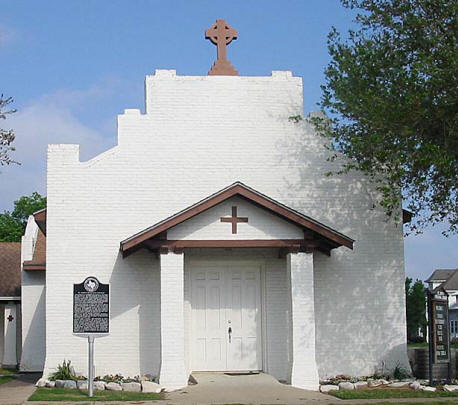 This
is a story of a church building constructed in a rural community and due
to decline of population and hurricanes was finally moved piece by piece
across a bay and by land to a more thriving town to become the permanent
church home of a second congregation.
This
is a story of a church building constructed in a rural community and due
to decline of population and hurricanes was finally moved piece by piece
across a bay and by land to a more thriving town to become the permanent
church home of a second congregation.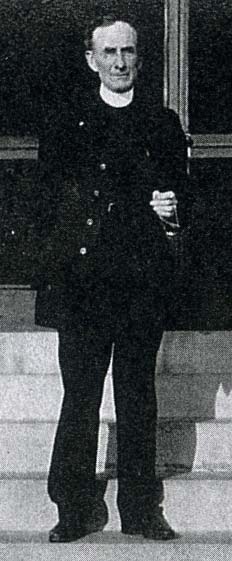 The first service in Grace Church of St. Mary’s
Mission was held in August, 1911, by Reverend Joan Sloan of St. Mark’s
Episcopal Church, Bay
The first service in Grace Church of St. Mary’s
Mission was held in August, 1911, by Reverend Joan Sloan of St. Mark’s
Episcopal Church, Bay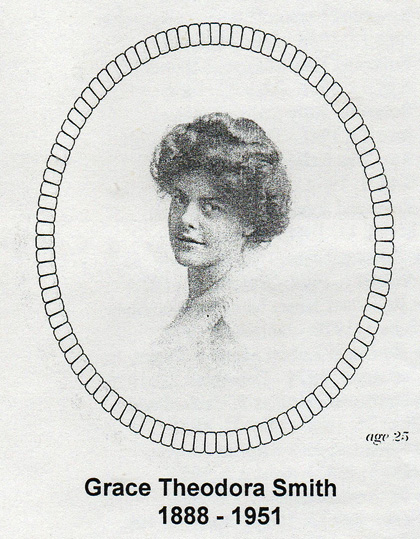 City. In addition to Collegeport people attending
the services were Mrs. John Sloan, the Misses Austin’s, Mrs. Bigelow and
Mrs. Miller from Bay City; Mr. and Mrs. Dean and Mr. and Mrs. Trego from
Palacios.
City. In addition to Collegeport people attending
the services were Mrs. John Sloan, the Misses Austin’s, Mrs. Bigelow and
Mrs. Miller from Bay City; Mr. and Mrs. Dean and Mr. and Mrs. Trego from
Palacios.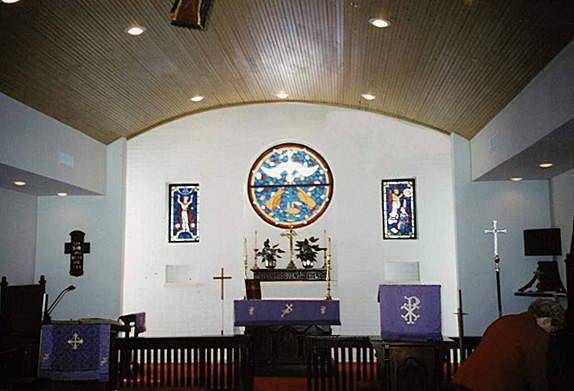 In 2003 major improvements were made to St. John’s
Episcopal Church. Concrete floors replaced wooden floors, new sheetrock
was installed inside, textured and painted. New carpet was installed,
new cushions on the pews and ceiling beams replaced as needed. The east
end of the church was added on making the church twenty feet longer. Two
small rooms were taken into the church, ceramic tile laid in the
entrance, and a closet on the right side of the entrance and a filming
room on the left. New stained glass donated by Grace Smith Henley was
installed and the outside bricks were painted. The Pybus Parish Hall was
painted inside and outside, the class rooms enlarged and a new ceiling
installed. On the east side of the property, a Christian Education
building is located. This building contains a nursery, playroom, two
rest rooms, Sacristy room, vestry room, vicar’s office, and the
secretary’s office.
In 2003 major improvements were made to St. John’s
Episcopal Church. Concrete floors replaced wooden floors, new sheetrock
was installed inside, textured and painted. New carpet was installed,
new cushions on the pews and ceiling beams replaced as needed. The east
end of the church was added on making the church twenty feet longer. Two
small rooms were taken into the church, ceramic tile laid in the
entrance, and a closet on the right side of the entrance and a filming
room on the left. New stained glass donated by Grace Smith Henley was
installed and the outside bricks were painted. The Pybus Parish Hall was
painted inside and outside, the class rooms enlarged and a new ceiling
installed. On the east side of the property, a Christian Education
building is located. This building contains a nursery, playroom, two
rest rooms, Sacristy room, vestry room, vicar’s office, and the
secretary’s office.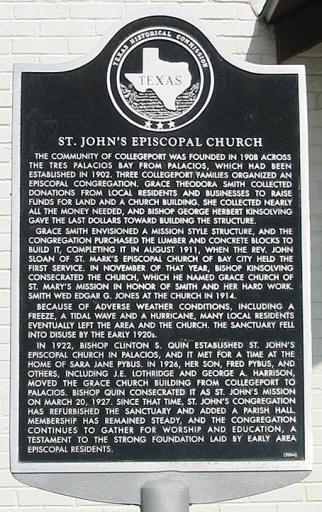 THE
COMMUNITY OF COLLEGEPORT WAS FOUNDED IN 1908 ACROSS THE TRES PALACIOS
BAY FROM PALACIOS, WHICH HAD BEEN ESTABLISHED IN 1903. THREE COLLEGEPORT
FAMILIES ORGANIZED AN EPISCOPAL CONGREGATION. GRACE THEODORA SMITH
COLLECTED FUNDS FOR LAND AND A CHURCH BUILDING. SHE COLLECTED NEARLY ALL
THE MONEY NEEDED, AND BISHOP GEORGE HERBERT KINSOLVING GAVE THE LAST
DOLLARS TOWARD BUILDING THE STRUCTURE.
THE
COMMUNITY OF COLLEGEPORT WAS FOUNDED IN 1908 ACROSS THE TRES PALACIOS
BAY FROM PALACIOS, WHICH HAD BEEN ESTABLISHED IN 1903. THREE COLLEGEPORT
FAMILIES ORGANIZED AN EPISCOPAL CONGREGATION. GRACE THEODORA SMITH
COLLECTED FUNDS FOR LAND AND A CHURCH BUILDING. SHE COLLECTED NEARLY ALL
THE MONEY NEEDED, AND BISHOP GEORGE HERBERT KINSOLVING GAVE THE LAST
DOLLARS TOWARD BUILDING THE STRUCTURE.